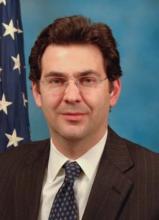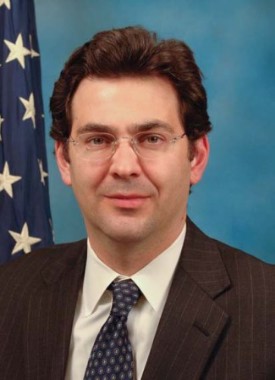User login
Fewer hospital readmissions, high-cost imaging studies, and emergency department visits helped 29 of 114 accountable care organizations earn $126 million in shared Medicare savings in 2012, the Centers for Medicare & Medicaid Services announced.
CMS issued interim financial results for the first year that ACOs participated in the Medicare Shared Savings Program. Under the program, ACOs that reduce costs while providing high-quality care can share in the savings to Medicare. They must report on 33 quality measures relating to care coordination and patient safety, use of appropriate preventive health services, improved care for at-risk populations, and patient and caregiver experience of care.
According to the report, 54 of 114 ACOs that started in 2012 spent less than anticipated, and 29 of the 54 collectively received $126 million as their share of the savings. Medicare kept $128 million of savings.
"What I think is impressive is that so many of the organizations did save in the first year," CMS Principal Deputy Administrator Jon Blum said. The agency had anticipated that more rebuilding systems of care, training and hiring new staff, and purchasing data systems would be required in the first year, Mr. Blum said, adding that savings – especially large savings – were not anticipated.
"We are tremendously surprised with the growth of the program," Mr. Blum said. "If these results and these growth trends continue, it’s going to be a continued phenomenal story for the Medicare program," he said.
CMS would not reveal which ACOs met their benchmarks, which were compensated for saving, or how much any ACO received. Mr. Blum said that data eventually would be published.
The agency also recalculated the first-year savings for the Pioneer ACO program. Pioneers must meet more aggressive quality and savings targets. According to the recalculation, 13 of 32 Pioneers hit their targets, and would share in $76 million in savings. Medicare kept $33 million.
An independent analysis by Washington, DC–based L&M Policy Research found that the total savings to the Pioneers and Medicare was $147 million – some $38 million more than what CMS had calculated. The new analysis takes into account factors that had not been figured in by the CMS, said an agency spokesman.
CMS also announced the final savings results for the 5-year Physician Group Practice Demonstration, which ran from 2005 to 2010. Ten physician groups participated in the program, which offered incentives for coordinating care and generating Medicare savings. Seven of the 10 groups met their targets and earned $108 million. All 10 practices are participating in a 2-year extension of the program.
And the agency announced that 232 acute care hospitals, skilled nursing homes, physician group practices, long-term care hospitals and home health agencies were moving into the next phase of the Bundled Payments for Care Improvement initiative. The participants were announced last January, and spent 2013 preparing to be accountable for episodes of care involving some 48 clinical conditions. The goal of the program is to encourage hospitals, physician, and other providers to work together to coordinate care for patients in the hospital and post discharge.
Starting this year, those 232 providers will now start bearing risk for the care they provide.
The agency has also added thousands of conditions that can become eligible for shared risk, said Dr. Patrick Conway, deputy administrator for innovation and quality at the CMS.
Final results for the first year of the Shared Savings Program will be released later in this year.
On Twitter @aliciaault
Fewer hospital readmissions, high-cost imaging studies, and emergency department visits helped 29 of 114 accountable care organizations earn $126 million in shared Medicare savings in 2012, the Centers for Medicare & Medicaid Services announced.
CMS issued interim financial results for the first year that ACOs participated in the Medicare Shared Savings Program. Under the program, ACOs that reduce costs while providing high-quality care can share in the savings to Medicare. They must report on 33 quality measures relating to care coordination and patient safety, use of appropriate preventive health services, improved care for at-risk populations, and patient and caregiver experience of care.
According to the report, 54 of 114 ACOs that started in 2012 spent less than anticipated, and 29 of the 54 collectively received $126 million as their share of the savings. Medicare kept $128 million of savings.
"What I think is impressive is that so many of the organizations did save in the first year," CMS Principal Deputy Administrator Jon Blum said. The agency had anticipated that more rebuilding systems of care, training and hiring new staff, and purchasing data systems would be required in the first year, Mr. Blum said, adding that savings – especially large savings – were not anticipated.
"We are tremendously surprised with the growth of the program," Mr. Blum said. "If these results and these growth trends continue, it’s going to be a continued phenomenal story for the Medicare program," he said.
CMS would not reveal which ACOs met their benchmarks, which were compensated for saving, or how much any ACO received. Mr. Blum said that data eventually would be published.
The agency also recalculated the first-year savings for the Pioneer ACO program. Pioneers must meet more aggressive quality and savings targets. According to the recalculation, 13 of 32 Pioneers hit their targets, and would share in $76 million in savings. Medicare kept $33 million.
An independent analysis by Washington, DC–based L&M Policy Research found that the total savings to the Pioneers and Medicare was $147 million – some $38 million more than what CMS had calculated. The new analysis takes into account factors that had not been figured in by the CMS, said an agency spokesman.
CMS also announced the final savings results for the 5-year Physician Group Practice Demonstration, which ran from 2005 to 2010. Ten physician groups participated in the program, which offered incentives for coordinating care and generating Medicare savings. Seven of the 10 groups met their targets and earned $108 million. All 10 practices are participating in a 2-year extension of the program.
And the agency announced that 232 acute care hospitals, skilled nursing homes, physician group practices, long-term care hospitals and home health agencies were moving into the next phase of the Bundled Payments for Care Improvement initiative. The participants were announced last January, and spent 2013 preparing to be accountable for episodes of care involving some 48 clinical conditions. The goal of the program is to encourage hospitals, physician, and other providers to work together to coordinate care for patients in the hospital and post discharge.
Starting this year, those 232 providers will now start bearing risk for the care they provide.
The agency has also added thousands of conditions that can become eligible for shared risk, said Dr. Patrick Conway, deputy administrator for innovation and quality at the CMS.
Final results for the first year of the Shared Savings Program will be released later in this year.
On Twitter @aliciaault
Fewer hospital readmissions, high-cost imaging studies, and emergency department visits helped 29 of 114 accountable care organizations earn $126 million in shared Medicare savings in 2012, the Centers for Medicare & Medicaid Services announced.
CMS issued interim financial results for the first year that ACOs participated in the Medicare Shared Savings Program. Under the program, ACOs that reduce costs while providing high-quality care can share in the savings to Medicare. They must report on 33 quality measures relating to care coordination and patient safety, use of appropriate preventive health services, improved care for at-risk populations, and patient and caregiver experience of care.
According to the report, 54 of 114 ACOs that started in 2012 spent less than anticipated, and 29 of the 54 collectively received $126 million as their share of the savings. Medicare kept $128 million of savings.
"What I think is impressive is that so many of the organizations did save in the first year," CMS Principal Deputy Administrator Jon Blum said. The agency had anticipated that more rebuilding systems of care, training and hiring new staff, and purchasing data systems would be required in the first year, Mr. Blum said, adding that savings – especially large savings – were not anticipated.
"We are tremendously surprised with the growth of the program," Mr. Blum said. "If these results and these growth trends continue, it’s going to be a continued phenomenal story for the Medicare program," he said.
CMS would not reveal which ACOs met their benchmarks, which were compensated for saving, or how much any ACO received. Mr. Blum said that data eventually would be published.
The agency also recalculated the first-year savings for the Pioneer ACO program. Pioneers must meet more aggressive quality and savings targets. According to the recalculation, 13 of 32 Pioneers hit their targets, and would share in $76 million in savings. Medicare kept $33 million.
An independent analysis by Washington, DC–based L&M Policy Research found that the total savings to the Pioneers and Medicare was $147 million – some $38 million more than what CMS had calculated. The new analysis takes into account factors that had not been figured in by the CMS, said an agency spokesman.
CMS also announced the final savings results for the 5-year Physician Group Practice Demonstration, which ran from 2005 to 2010. Ten physician groups participated in the program, which offered incentives for coordinating care and generating Medicare savings. Seven of the 10 groups met their targets and earned $108 million. All 10 practices are participating in a 2-year extension of the program.
And the agency announced that 232 acute care hospitals, skilled nursing homes, physician group practices, long-term care hospitals and home health agencies were moving into the next phase of the Bundled Payments for Care Improvement initiative. The participants were announced last January, and spent 2013 preparing to be accountable for episodes of care involving some 48 clinical conditions. The goal of the program is to encourage hospitals, physician, and other providers to work together to coordinate care for patients in the hospital and post discharge.
Starting this year, those 232 providers will now start bearing risk for the care they provide.
The agency has also added thousands of conditions that can become eligible for shared risk, said Dr. Patrick Conway, deputy administrator for innovation and quality at the CMS.
Final results for the first year of the Shared Savings Program will be released later in this year.
On Twitter @aliciaault

